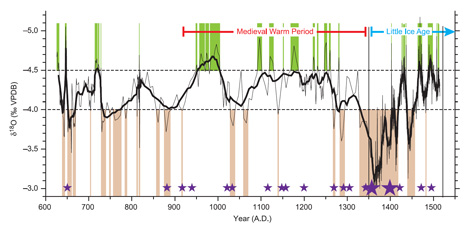Reference
Sinha, A., Cannariato, K.G., Stott, L.D., Cheng, H., Edwards, R.L., Yadava, M.G., Ramesh, R. and Singh, I.B. 2007. A 900-year (600 to 1500 A.D.) record of the Indian summer monsoon precipitation from the core monsoon zone of India. Geophysical Research Letters 34: 10.1029/2007GL030431.
Description
Working with data collected from India's Dandak Cave (19°00'N, 83°00'E), the authors derived a near-annually resolved record of Indian summer monsoon rainfall variations for the core monsoon region of India for the period 600-1500 AD, based on a 230Th-dated stalagmite δ18O record. This work revealed the existence of the Medieval Warm Period, which they designated as occurring between about AD 920 and 1340, and which they found to have been a much wetter regime than the subsequent Little Ice Age.

Indian summer monsoon precipitation proxy for Dandak Cave. The thick line is a 9-point running mean. Dashed lines indicate the δ18O range of calcite from Dandak Cave stalagmites deposited during the modern instrumental period. Intervals of inferred stronger monsoon are shaded green and intervals of weaker monsoon are shaded brown. Purple stars indicate timing of historical famines in India (two large stars indicate decadal length famines).




